Overview
The article examines the essential features of 1U CPU fans that are pivotal for achieving optimal performance. Key technologies, such as PWM control, low-profile designs, and effective noise management, are discussed in detail. These features significantly enhance thermal regulation, improve airflow, and ensure reliability within compact server environments. As data centers increasingly demand efficient cooling solutions to address rising energy consumption, the importance of these advancements cannot be overstated.
Introduction
The escalating power demands of data centers have rendered efficient cooling solutions more vital than ever, particularly within compact server environments. Among these solutions, 1U CPU fans emerge as essential components, meticulously engineered to optimize thermal performance while preserving space efficiency.
As technology continues to evolve, it is imperative to identify the key features that set high-performing 1U CPU fans apart from their counterparts. Furthermore, engineers must explore how to harness these innovations to bolster system reliability and longevity.
Gagner-Toomey Associates: Innovative Cooling Solutions for 1U CPU Fans
Gagner-Toomey Associates stands at the forefront of innovative thermal management systems specifically tailored for the electronics sector, emphasizing their expertise in 1U CPU fans. Their unwavering commitment to excellence ensures that engineers have access to the latest advancements in temperature regulation technology, which are vital for maintaining optimal thermal conditions in compact server environments. As of 2023, the demand for effective refrigeration solutions has surged, driven by the increasing power consumption of data centers, which accounted for 7.4 Gigawatts of energy usage—a staggering 55% rise from the previous year. This trend underscores the critical need for .
The market for 1U CPU fans is evolving rapidly, as features like PWM control and reversible flow devices significantly enhance the performance and operational efficiency of the 1U CPU fan. These technologies not only improve airflow management but also reduce maintenance needs, making them ideal for environments where reliability is paramount. For instance, reversible flow devices can change airflow direction, effectively cleaning airways and minimizing dust accumulation—essential for preserving the longevity of sensitive equipment.
Moreover, the market share for innovative temperature regulation technologies is projected to expand considerably, with the data center temperature management market expected to reach USD 42.48 billion by 2032, indicating a CAGR of 12.4% from 2025 to 2032. This growth is fueled by the rising use of cloud services and the demand for effective temperature management in high-density computing environments.
Gagner-Toomey Associates collaborates with a diverse range of manufacturers to deliver high-quality temperature control solutions that meet the evolving needs of engineers and consumers alike. Their dedication to integrating stylish and energy-efficient designs into small DC devices aligns with contemporary trends, rendering these products not only functional but also visually appealing for modern applications. As the industry increasingly focuses on energy efficiency and sustainability, Gagner-Toomey remains a pivotal player in advancing innovation in cooling technologies for the 1U CPU fan.

Low-Profile Design: Essential for Space Efficiency in 1U CPU Fans
Low-profile designs are indispensable for 1U CPU fan systems, enabling seamless integration into confined server environments. Typically measuring 27mm or less in height, these devices, known as , are meticulously engineered for 1U rackmount servers, optimizing airflow and preventing overheating in compact configurations.
Gagner-Toomey Associates offers a diverse range of low-profile temperature regulation solutions, including advanced DC input Tube Axial units specifically optimized for performance and efficiency. These devices are designed to operate at minimal noise levels while providing effective ventilation in restricted areas.
Moreover, Gagner-Toomey’s low-profile units, which include the 1U CPU fan, excel in heat dissipation, accommodating a maximum thermal design power (TDP) of 95W, making them suitable for various CPU loads. As server density escalates, the necessity for space-efficient cooling solutions becomes critical, positioning low-profile designs as a vital consideration for contemporary server architectures. This emphasis on space efficiency not only enhances thermal management but also contributes to improved reliability and performance in high-density environments.

Noise Level Management: Ensuring Quiet Operation in 1U CPU Fans
Effective noise level management is crucial for 1U CPU fan systems, particularly in environments where multiple units operate simultaneously. Advanced designs leverage technologies like Pulse Width Modulation (PWM) to dynamically adjust fan speeds based on thermal demands, significantly reducing noise during low-load scenarios. For example, PWM devices can operate at lower speeds, achieving average decibel levels of around 24.6 dB(A), making them ideal for noise-sensitive applications. Brands such as Noctua exemplify this quiet operation by incorporating features that enhance performance while ensuring a tranquil environment.
Industry experts emphasize that investing in PWM technology facilitates more precise fan speed adjustments relative to temperature, guaranteeing effective cooling without sacrificing noise levels. Moreover, PWM units generally offer quieter operation, enhanced controllability, and a longer lifespan compared to DC units. To further mitigate noise, employing proves advantageous. Additionally, maintaining a clean PC environment is vital to prevent dust accumulation, which can obstruct airflow and elevate noise levels.
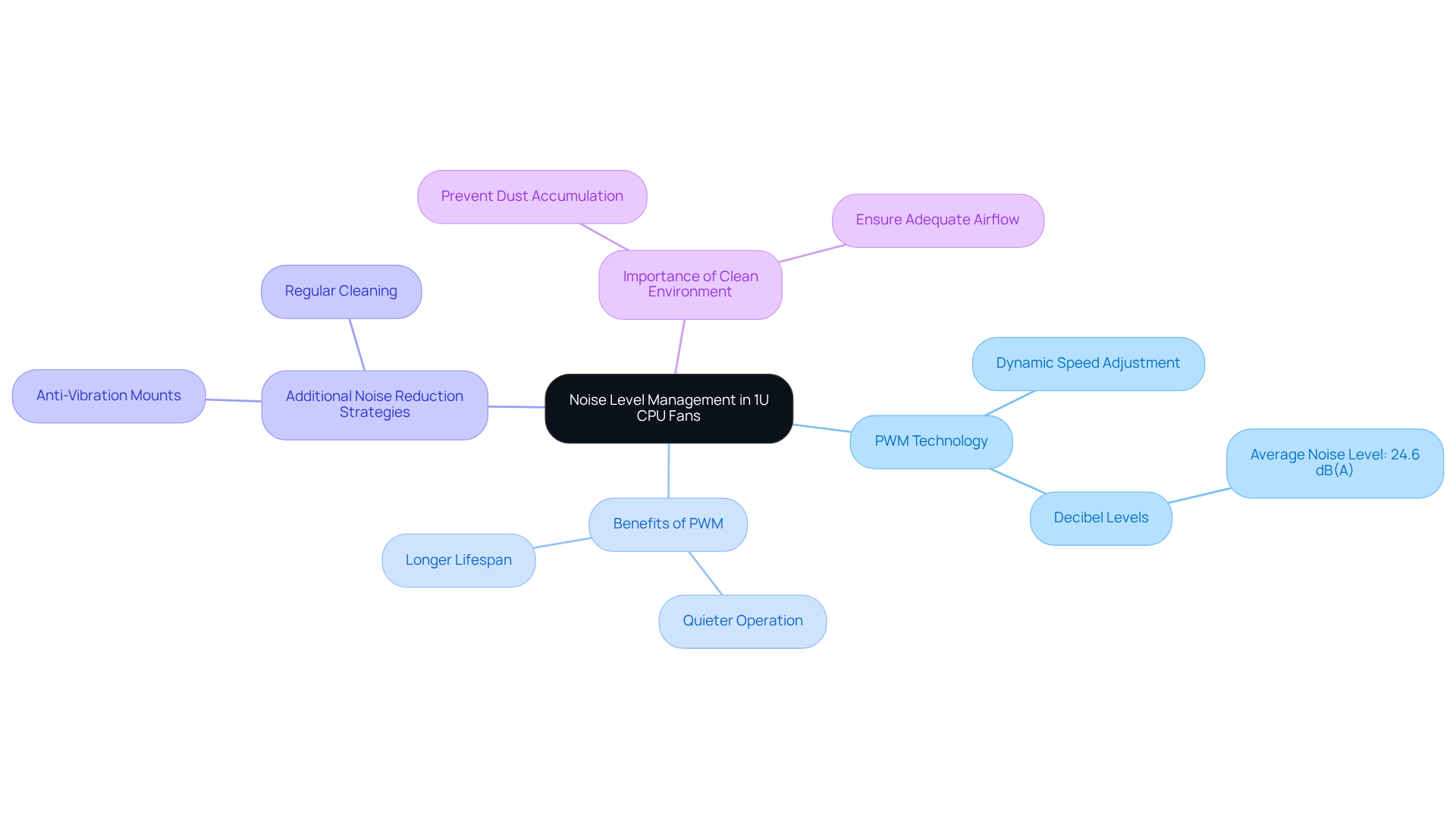
Thermal Performance: Key to Effective Cooling in 1U CPU Fans
Thermal performance is crucial for 1U CPU fans, as they play a key role in dissipating heat from high-performance processors. Gagner-Toomey Associates employs efficient temperature regulation methods, utilizing high-quality bearings and optimized blade designs to enhance airflow and static pressure. Their extensive product range includes:
- DC input tube axial devices ranging from 15 to 280mm
- Centrifugal blowers from 15 to 225mm
These products are specifically engineered to maintain optimal thermal conditions across various applications, such as electronics, automotive, and industrial sectors. This commitment ensures that the 1U CPU fan helps CPUs operate within , thereby prolonging their lifespan and enhancing overall system reliability. Gagner-Toomey’s innovative cooling solutions cater to diverse applications, solidifying their position as a leading provider in the field of thermal management for electronics.

Socket Compatibility: Ensuring Versatility in 1U CPU Fans
Socket compatibility stands as a critical characteristic of the 1U CPU fan coolers, significantly impacting their performance across diverse CPU architectures. A substantial percentage of modern cooling devices, including those from Gagner-Toomey Associates, are engineered to accommodate multiple socket types, such as Intel LGA 1151 and AMD AM4, thereby enhancing their adaptability. This versatility empowers engineers to upgrade or substitute components seamlessly without necessitating a change in the temperature regulation solution, presenting a cost-efficient strategy for server management.
Notably, numerous 1U CPU fans can support CPU TDP up to 250 Watts, ensuring they meet the thermal requirements of various processors while maintaining optimal performance. Users have remarked, “This is a good system for (mini-itx or 1U),” which underscores the versatility of these devices in environments where efficiency and reliability are paramount.
Furthermore, Gagner-Toomey’s 1U CPU fan can significantly lower CPU temperatures, achieving reductions of 30C at idle and 20C under full load, highlighting their efficiency in practical applications. Additionally, considering noise-reducing features is essential, as these devices are designed to operate silently, making them ideal for sound-sensitive environments.
Gagner-Toomey also provides a comprehensive range of cooling solutions, including various fan sizes and types, ensuring that engineers have access to the appropriate products for their specific needs. Ultimately, engineers should consistently verify socket compatibility when selecting a CPU fan to guarantee optimal performance and reliability.
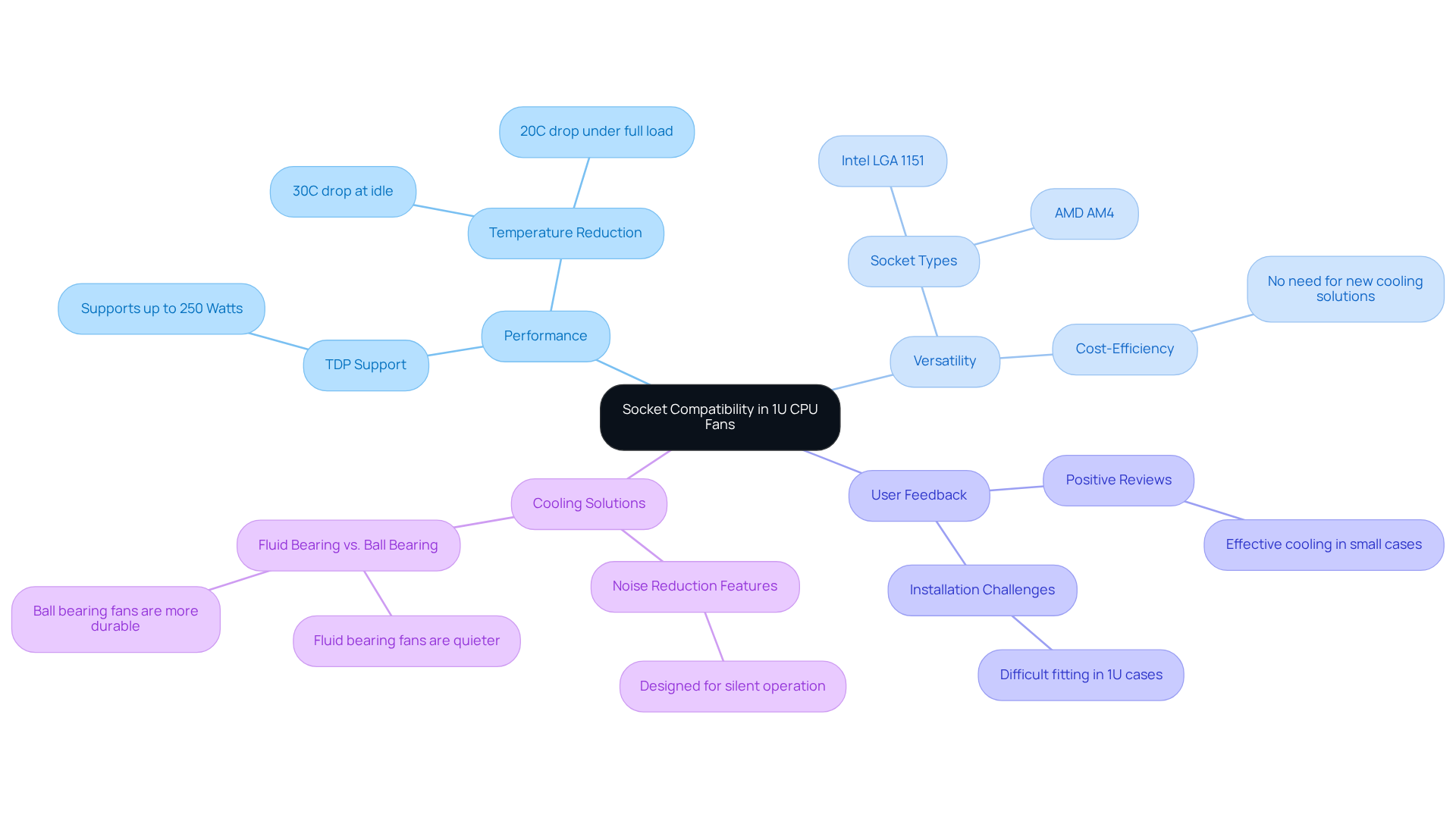
Airflow Design: Maximizing Cooling Efficiency in 1U CPU Fans
Airflow design is critical for optimizing the efficiency of the 1U CPU fan. High-performance fans are meticulously engineered, featuring specialized blade geometries and advanced motor technologies that enhance airflow while minimizing turbulence.
For instance, innovative aerodynamic designs significantly improve airflow efficiency, ensuring effective heat dissipation from the CPU and its surrounding components. This meticulous attention to airflow dynamics not only maintains optimal operating conditions but also contributes to overall .
As the demand for temperature regulation intensifies, the ongoing development of fan design remains vital for enhancing efficiency. According to Sophia Vo, the Global Data Center Temperature Regulation Market is projected to expand at over 13.5% CAGR from 2024 to 2032, underscoring the increasing importance of efficient temperature management solutions.
Furthermore, understanding the impact of ITE inlet temperature on energy consumption is essential, as it directly influences the effectiveness of cooling strategies.
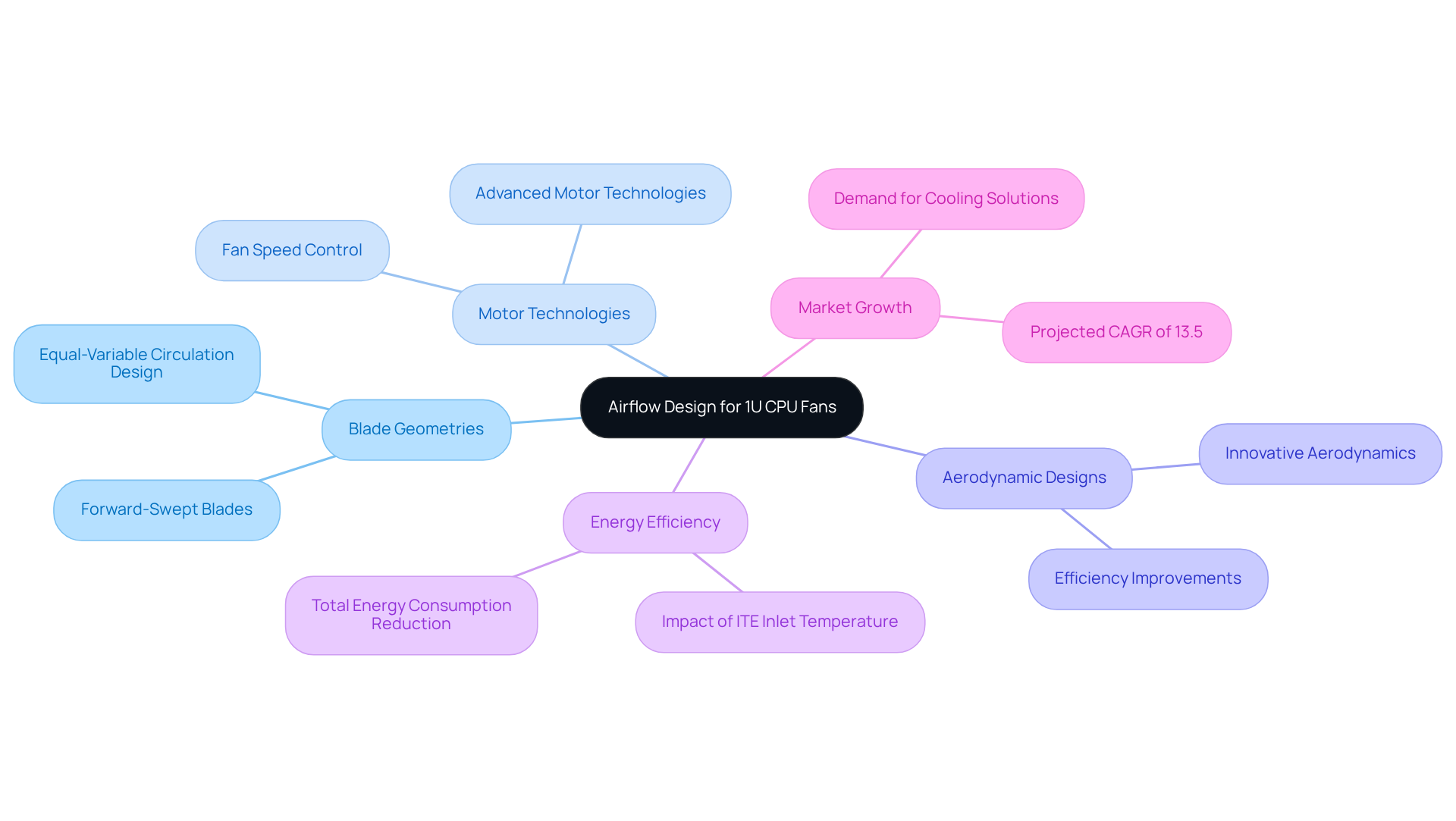
Fan Speed Control: Adapting Cooling Performance in 1U CPU Fans
Speed regulation stands as a pivotal element in modern 1U CPU fan coolers, empowering them to modulate their performance in response to real-time thermal conditions. Technologies such as Pulse Width Modulation (PWM) enable devices to operate at varying speeds, effectively reducing energy consumption and noise levels during low-load scenarios. This adaptability not only enhances the efficiency of temperature management but also contributes to the of server operations, reflecting Gagner-Toomey’s unwavering commitment to innovative solutions.
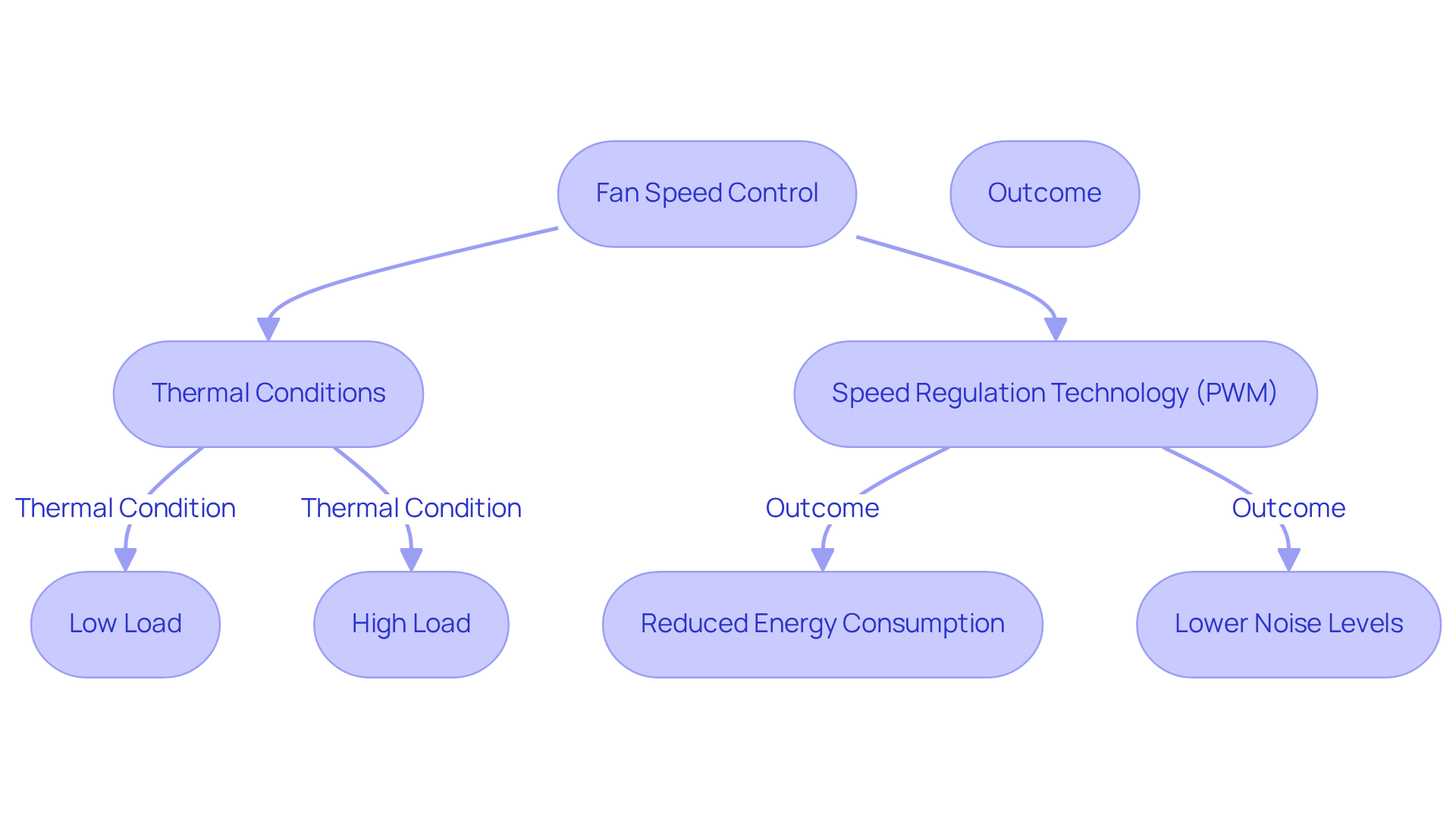
Durability and Reliability: Ensuring Longevity in 1U CPU Fans
Durability and reliability are paramount in the design of cooling devices, especially for the 1U CPU fan, as these components frequently operate under demanding conditions. Gagner-Toomey Associates, recognized as the world’s largest manufacturer of both standard and custom air-movers, ensures longevity by utilizing high-quality materials, including reinforced plastics and metal bearings, which are celebrated for their resilience.
For example, magnetic bearings, boasting an anticipated lifespan of up to 200,000 hours, exemplify the commitment to quality inherent in fan design, while traditional ball bearings provide a mean time between failures (MTBF) of approximately 75,000 hours.
Furthermore, Gagner-Toomey’s comprehensive portfolio includes direct contact heat pipes, acknowledged as the most efficient solution for rapid heat transfer from the CPU, thereby enhancing thermal performance.
To validate the reliability of these devices, are implemented, confirming their ability to withstand continuous operation without failure. This significantly reduces downtime and maintenance costs.
Such a focus on robust materials and thorough testing underscores the critical importance of selecting dependable cooling solutions, like a 1U CPU fan, for demanding applications.
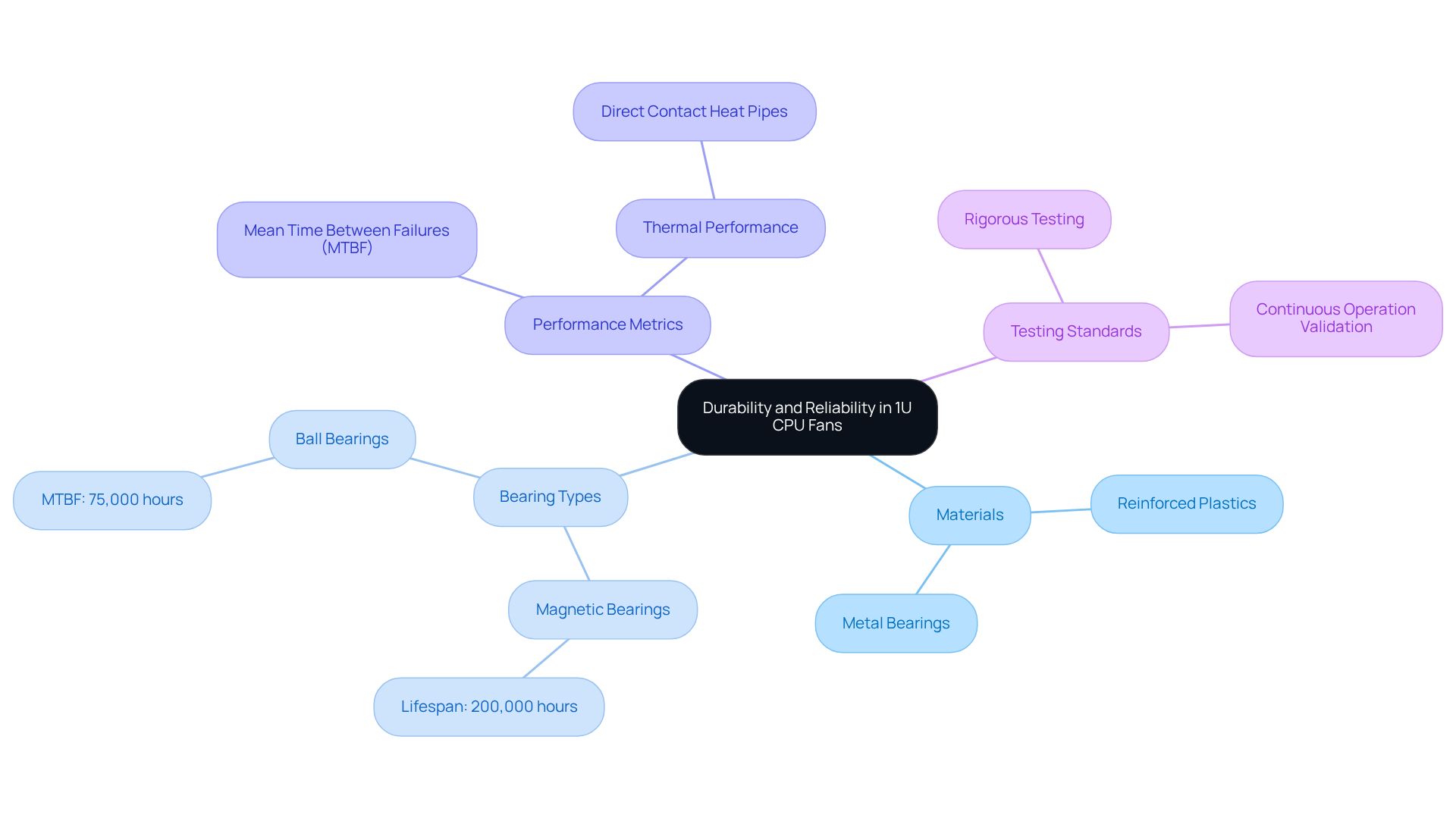
Ease of Installation: Simplifying Setup for 1U CPU Fans
The simplicity of installation is crucial for a 1U CPU fan, especially in server environments where rapid deployment is essential. Contemporary fans often incorporate user-friendly mounting systems that enable tool-less installation, thereby significantly reducing setup time and effort. This design approach not only streamlines the integration of temperature control systems but also enhances overall operational efficiency.
For example, tool-less installation can reduce average setup times by as much as 50%, allowing engineers to concentrate on optimizing system performance rather than grappling with intricate assembly processes. Gagner-Toomey Associates exemplifies this principle in their product offerings, ensuring that engineers can promptly and effectively implement temperature control methods tailored to their specific requirements.
User feedback consistently underscores the importance of intuitive designs in , reinforcing the trend towards simplifying installation processes to address the demands of modern data centers.
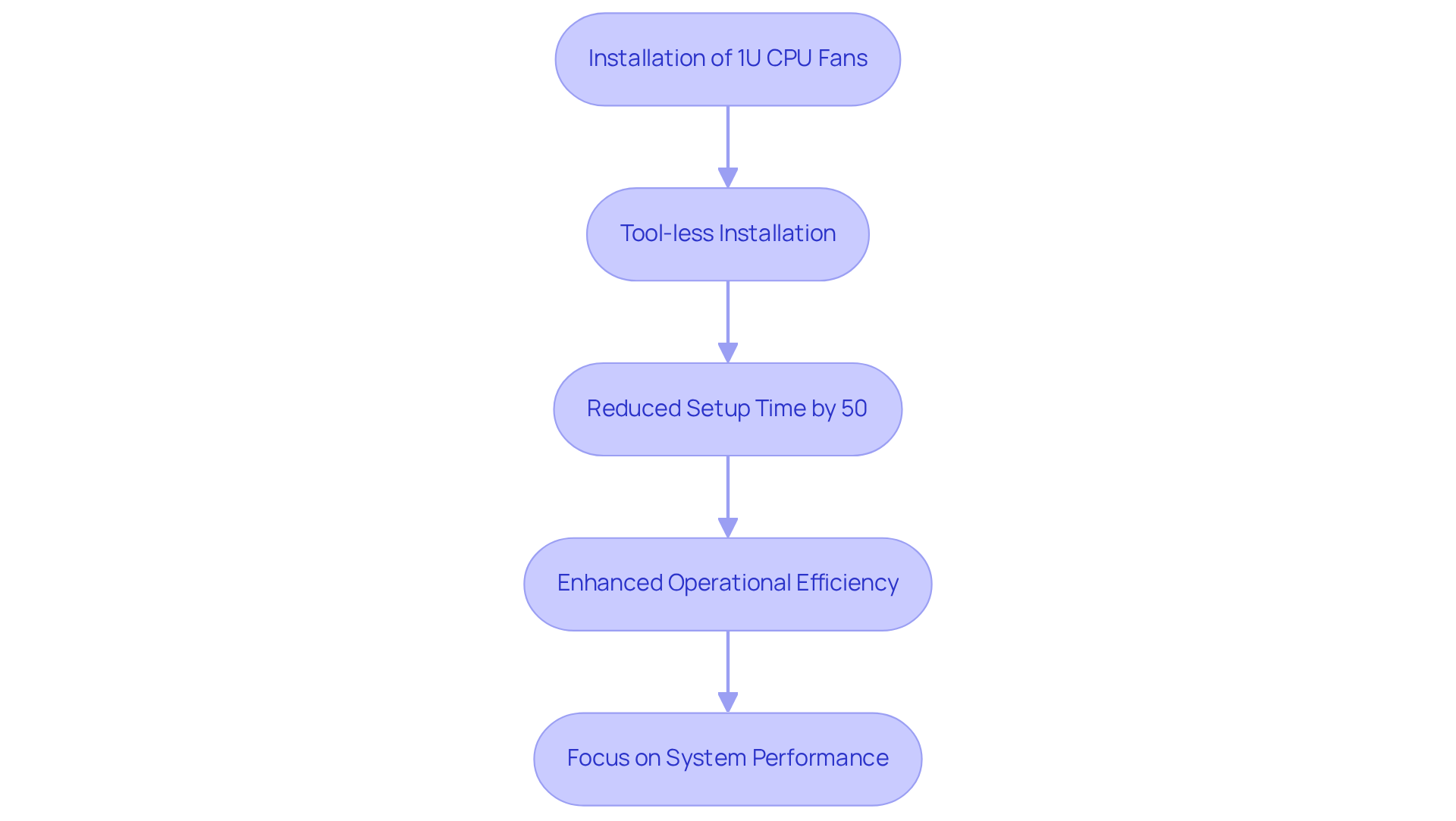
Warranty and Support: Key Considerations for 1U CPU Fans
When selecting a 1U CPU fan, emerge as critical factors that reflect the manufacturer’s confidence in their products. A comprehensive warranty not only safeguards the investment but also assures users of the fan’s performance and longevity. Many manufacturers provide standard warranties lasting for one year, with options to extend coverage up to five years, demonstrating their commitment to quality and reliability. This level of assurance is essential in the electronics thermal management sector, where performance consistency is paramount.
Moreover, robust manufacturer support significantly enhances customer satisfaction. Statistics indicate that customers who receive timely and effective support are more likely to express satisfaction with their purchases. For instance, Aroleap distinguishes itself by providing transparent warranty terms, emphasizing clarity and understanding for consumers, alongside dedicated customer service that ensures users can easily navigate any issues that arise. This commitment to support fosters trust and loyalty among customers, making it a key differentiator in a competitive market, especially when many competitors offer minimal or shorter warranty periods with exclusions.
In summary, a strong warranty and responsive support system not only protect the consumer’s investment in a 1U CPU fan but also reflect the manufacturer’s confidence in their cooling solutions, ultimately leading to higher customer satisfaction and long-term reliability.
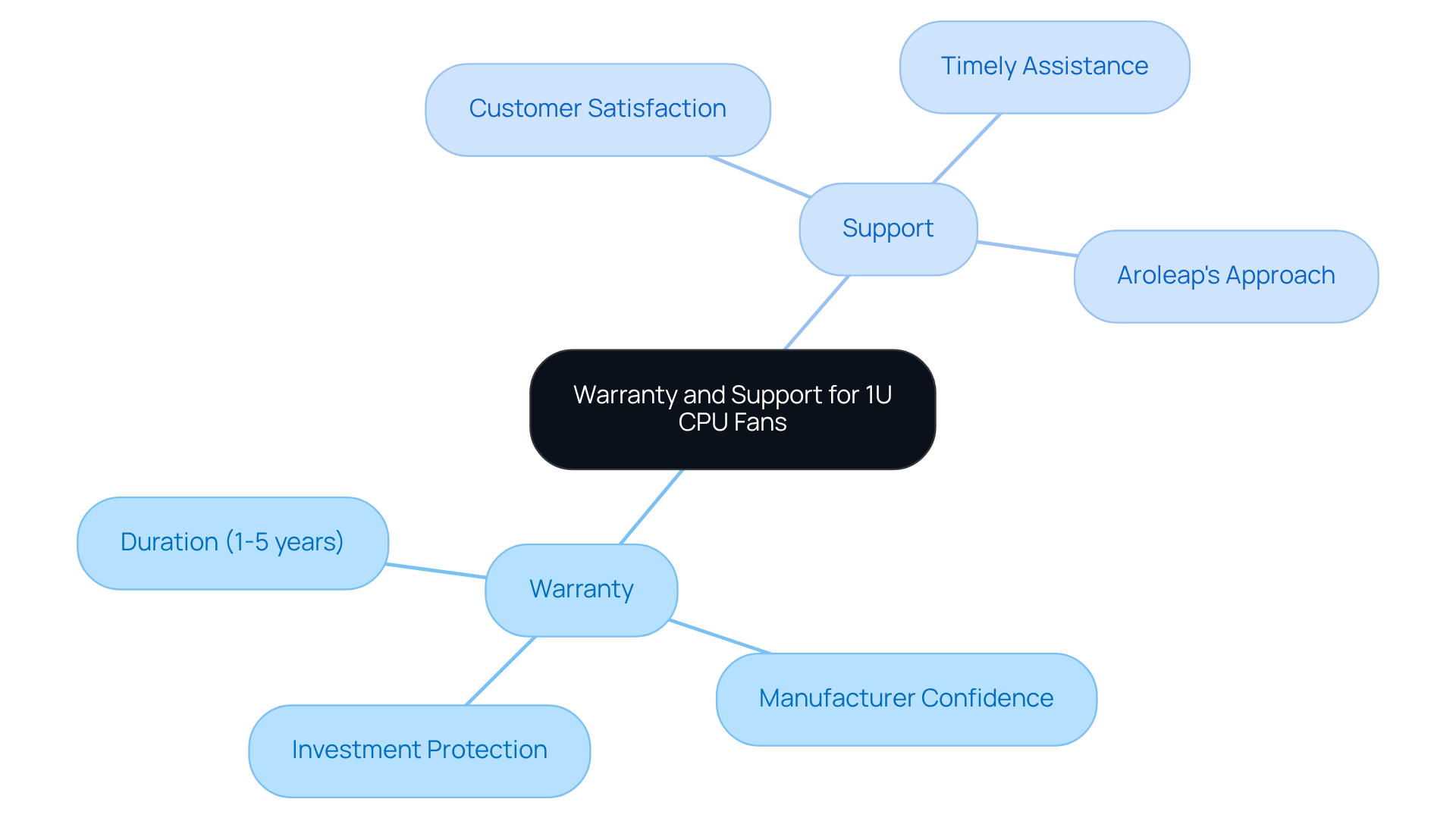
Conclusion
The significance of 1U CPU fans is paramount, as they are critical components in maintaining optimal thermal conditions within compact server environments. With the escalating energy demands of data centers, the advancement of cooling technologies, such as those provided by Gagner-Toomey Associates, is essential for ensuring efficient performance and the longevity of sensitive electronic equipment.
Key features of 1U CPU fans are highlighted, including:
- Low-profile designs that optimize space
- Effective noise management through PWM technology
- Superior thermal performance that prolongs CPU lifespan
The importance of socket compatibility and airflow design is emphasized, demonstrating how these elements contribute to the overall efficiency and reliability of cooling solutions. Furthermore, considerations surrounding durability, ease of installation, and robust warranty support are identified as vital factors for users seeking dependable and effective cooling systems.
Ultimately, investing in high-quality 1U CPU fans is crucial for achieving optimal performance in modern server architectures. As the demand for efficient temperature management continues to rise, prioritizing advanced cooling solutions will not only enhance operational efficiency but also support the sustainability goals of data centers. Embracing these innovative technologies ensures that engineers can meet the challenges of high-density computing environments while safeguarding the longevity and reliability of their systems.
Frequently Asked Questions
What is Gagner-Toomey Associates known for?
Gagner-Toomey Associates specializes in innovative thermal management systems for the electronics sector, particularly focusing on 1U CPU fans and advanced temperature regulation technologies.
Why is there an increasing demand for effective cooling solutions in data centers?
The demand for effective cooling solutions has surged due to the rising power consumption in data centers, which accounted for 7.4 Gigawatts of energy usage in 2023, marking a 55% increase from the previous year.
What technologies enhance the performance of 1U CPU fans?
Technologies such as PWM (Pulse Width Modulation) control and reversible flow devices enhance the performance of 1U CPU fans by improving airflow management and reducing maintenance needs.
How do reversible flow devices benefit 1U CPU fans?
Reversible flow devices can change the direction of airflow, which helps clean airways and minimize dust accumulation, thus preserving the longevity of sensitive equipment.
What is the projected market growth for temperature management technologies in data centers?
The data center temperature management market is expected to reach USD 42.48 billion by 2032, with a compound annual growth rate (CAGR) of 12.4% from 2025 to 2032.
What role does Gagner-Toomey Associates play in the market?
Gagner-Toomey Associates collaborates with various manufacturers to provide high-quality temperature control solutions that meet the evolving needs of engineers and consumers, focusing on energy efficiency and stylish designs.
What is the significance of low-profile designs in 1U CPU fans?
Low-profile designs, typically measuring 27mm or less in height, are essential for seamless integration into confined server environments, optimizing airflow and preventing overheating in compact configurations.
What are the thermal capabilities of Gagner-Toomey’s low-profile units?
Gagner-Toomey’s low-profile units, including the 1U CPU fan, can accommodate a maximum thermal design power (TDP) of 95W, making them suitable for various CPU loads.
How does noise level management work in 1U CPU fan systems?
Noise level management is achieved through advanced designs that use PWM technology to adjust fan speeds based on thermal demands, significantly reducing noise during low-load scenarios.
What are the benefits of using PWM technology in 1U CPU fans?
PWM technology allows for precise fan speed adjustments relative to temperature, resulting in effective cooling, quieter operation, enhanced controllability, and a longer lifespan compared to traditional DC units.
What additional measures can reduce noise levels in 1U CPU fan systems?
Employing anti-vibration mounts and maintaining a clean PC environment to prevent dust accumulation can further mitigate noise levels in 1U CPU fan systems.

